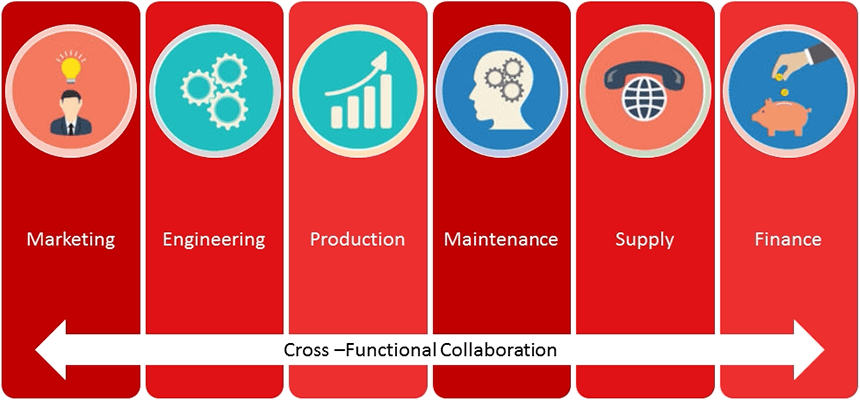
Click the button to start reading
Your Guide to Building a Stellar Cross-Functional Team
Look around. Command-and-control leadership culture is breaking down․ Communication barriers are crumbling. Companies are combating the silo mentality. Different minds playing different roles are being brought together. In present-day project management, there is hardly any going back.
Today, when project managers are increasingly searching for productive team collaboration methods, it’s no surprise that cross-functional teams are gaining momentum. They have the potential to spark innovation, drive cohesion, and help you optimize efforts for the best possible results.
Whether you’re building a cross-functional team from scratch or leveling up an existing one, this comprehensive guide will help you get prepared for sustainable and predictable growth.
What is a cross-functional team?
A cross-functional team includes employees from different departments of an organization and engages diverse expertise for interconnected collaboration.
In other words, building cross-functional teams is about putting people from different functional areas of the company – sales, engineering, marketing, research, or customer success – to pursue a common goal.

Image source: Orgzit
In cross-functional teams, people bring their unique knowledge, skill set, and experience to the table for better efficiency, faster turnaround, and enhanced skills.
Examples of cross-functional teams
The definition of cross-functional teams may seem quite straightforward. But there is more to explore, depending on the type of business you’re in.
If you’re a small business, you probably have a cross-functional team by default because you lack the resources to create specialized teams and departments.
In the case of larger companies, two main options can be outlined:
- having cross-functional teams as their primary structure, or
- setting up such teams as working groups to complete a specific project. People from different authority levels may be included in the team to eliminate bureaucracy in decision-making and push forward collaborative leadership.
A temporarily made-up cross-functional team usually consists of up to five people; employees from sales, engineering, and marketing teams can come together to deliver on a stated promise. In certain instances, the project manager may decide to bring in data analysts and growth advisors, too.
In the IT environment, such teams may engage a project or product manager, front-end developer, back-end developer, and designer.
Real-life examples show that it’s preferable to keep teams either entirely remote or solely co-located. Don’t mix it up. Otherwise, you risk compromising the project’s speed and overall success.

Why are cross-functional teams important?
The rapidly-changing business environment has left companies with few options. Actually, with two options only. You either adapt, or you’re out.
Cross-functional teams have come to make a loud statement that nobody has all the answers anymore. When people join efforts to collaborate smartly, they help the companies move faster and survive severe fluctuations.
Today, when there is an immense shift towards customer-facing approaches, a company functioning in silos may be one of the biggest reasons your customer feels dissatisfied. Moreover, with the increased use of scrum and agile frameworks, cross-functional teams become the most logical – if not the only – solution.
When you align different functions within the company towards a shared goal, you increase your chances of providing top-notch customer service and gaining a strategic advantage in the market.

Key indicators of effective cross-functional teams
The pros of cross-functional teams are usually linked to business processes and team performance.
1. Better goal alignment
Successful cross-functional teams align their efforts toward an organizational goal ensuring that no secondary issues get under their feet.
The company’s time and money are used optimally, because people don’t represent different departments that fight for resources (and for attention!). This leads to more sustainable solutions and practices across the organization.
2. Streamlined processes
Cross-functional collaboration improves coordination and integration, and problems start to get resolved quicker. You have the needed folks around the table, so you encounter fewer communication errors.
People don’t waste time scheduling meetings and coming together for each question. For example, instead of passing a customer request from department to department, you foster cross-functionality to offer faster response, reduced project management lifecycle, and better customer experience.
3. Deeper cohesion
When your daily work is summed up by being heads down in product design or DevOps, you deprive yourself of an amazing opportunity to talk to your counterparts and share constructive feedback.
Alternatively, when people from different departments are brought together and collaborate to deliver a project, they cultivate a team spirit and a sense of cohesion. Cross-functional relationships within a company keep the communication flowing and maintain velocity even during challenging times.
4. Meaningful insights
An HR team may find it hard to view things from the perspective of the Operations department, or the Dev team may need guidance to see how their work affects customer success… Wait. How about revealing the complete spectrum of strengths?
When people don’t operate from a single mindset and are willing to synchronize their efforts, better insights are born. A case in point. Product Manager Natalie Mandriko states that “cross-functional collaboration empowers product growth” because decisions are based on rich sources of information: input from the product user, UX design, marketing campaign data, sales conversations, and more.
Multiple solutions from different perspectives also mean that everyone is invested in the project outcome, so all members feel motivated to abandon the silo role and make the most out of the cross-functional collaboration.
5. Enhanced creativity
Without the right environment that welcomes and encourages idea-sharing, no one is going to step out of their comfort zone and shower you with dozens of fresh ideas. You should walk the talk by showing that thinking out of the box is what you’re looking for as a project manager.
Team members need a risk-free environment to reject an idea, suggest a viable alternative, and cultivate trust and accountability.
That’s why having cross-functional teams isn’t only about having people with various skills but also bringing in folks from different ranks and practicing flat hierarchy in a real mode.
6. New skills
In broader terms, cross-functionality helps develop T-shaped skills. The concept of T-shaped skills is a metaphor used to describe people’s abilities in the workforce. As defined in an article by Crystal Schaffer:
“T-shaped people have a depth of skill in one area—the vertical line of the “T”—and an ability to work cross-functionally across disciplines—the horizontal line of the “T.”
First, each member on the cross-functional team gets a unique opportunity to polish their communication and interpersonal skills.
Second, cross-functional teams can involve subject matter experts (who may not be available on a regular basis) and open the doors to latest knowledge in the industry.
Furthermore, each member might be put into a managerial role for a specific period of time. Thus, being the boss enables employees to step out of their field-specific expertise and test their abilities in something more.
Want an added benefit? When employees are growing as professionals, they’re more likely to stay and contribute to the greater good. This, eventually, increases the much-desired retention rate in the company!
By now, you feel excited, and you may rush to test the benefits of cross-functional teams in real life. But the uncomfortable reality is – there are flipsides to be aware of. Managed incorrectly, cross-functional teams may get stuck and cause friction.

Why do cross-functional teams fail?
Acknowledging the weak points can help you weigh the pros and cons of cross-functional teams and make informed decisions.
1. Competing obligations
Employees join cross-functional teams with existing responsibilities and individual styles of working. Those differences aren’t going to vanish in a day. When put on the same team, people may continue pursuing their department’s interests and unconsciously prioritize their tasks over the team goals (and at the expense of the final results). To fight the sense of reduced ownership, support your team in adopting new strategies and succeeding together.
2. Extra work
Cross-functional collaboration can be extra work for those who should juggle between their departmental responsibilities and those on the new teams. This may create pressure and frustration.
It’s crucial to make sure no one on the team is falling short, and everyone takes over their share of the burden. You have to find the right people with the right mindset who are ready to realize their potential while being part of a team and staying flexible.
3. Absence of trust
If it’s the first time people from different departments come together to form a new team, you can expect a lack of mutual understanding and camaraderie. And people aren’t to blame for this. They might have met at a corporate party, but things have changed now – they need to work towards a common goal together.
Cross-functional approaches provide a great chance to show empathy and better understand the functions of other teammates. Right from the very beginning, there should be special attention to cultivating respect, trust, and team spirit. Having open and honest conversations with your counterparts is absolutely crucial.
4. Lack of ownership and inability to work independently
Many employees prefer a babysitting approach (although they might not confess it). Similarly, many teams don’t have genuine independence and the ability to execute their plan without excessive coordination.
For the cross-functional team to function, people should be encouraged to take ownership, work independently, and be responsible for the results they produce.
5. Breaking through the top-down leadership
We’re wired to seek a sense of belonging to a team. We need discipline and control. We continuously ask for processes that will guide us every step of the way. And rightfully so because when things get messy and uncomfortable, it’s the existing structure that keeps us safe. Hence, the hardest of the challenges – balancing the valid need for structure and the pressing urge for growth.
Even if you’re confident enough to let go of control, it’ll take time to persuade people that they need to feel less safe and less knowledgeable to grow.
The solution is to increase the team’s autonomy and create opportunities to work with minimal supervision. Allow your team members to self-reflect, raise questions, and “own” their solutions. If you’ve chosen the right people for your cross-functional team, they’re going to thank you for the exclusive opportunity to unlock their inner power.
By now, you know how cross-functional teams are different from regular ones and what main advantages they may provide. Let’s move on and get acquainted with the best practices of building a successful cross-functional team.

How to build a cross-functional team?
1. Bring the right people on board
If you struggle to make your mind as to who should be on your cross-functional team, answering the following questions will guide your decision:
- What expertise do you need?
- Do people have prior experience working with cross-functional approaches?
- Do they have the skills to work independently and make useful recommendations?
- Who are the stakeholders? Do you need to have a representative of each stakeholder group on your team?
- Do you need a leader who will hold everyone accountable?
- What’s the level of authority the leader should have?
To reap the full value of cross-functional solutions, ask potential candidates to share stories that benefitted the entire team, such as helping improve a process or refining a certain structure.
In addition, dig deeper into what kind of impact the candidate wants to make. If they emphasize the impact on the team and the end user, you’ve got the perfect fit!
Take a hard stance on this and search for people who prioritize having empathy for the customer and achieving accomplishments as a team.
2. Start early or start small
If you’re making your first steps in the business world and have a team of five people trying to make a change, it’s the right time to learn the basics of cross-functional collaboration. The hierarchy and strong dependency are not yet there, and the internal processes are easier to frame according to your needs.
As a big company, consider starting with a pilot team and help them test the given autonomy. Set KPIs and be clear about the project goals. Once you see it working successfully, you can scale it up.
Build conversations between department leaders who will bring relevant information to your meetings. Ask yourself: who are the stakeholders involved in the value chain, and how do I bring in their input to provide a top-notch customer experience?
3. Work on a single metric
Clearly identified metrics allow for increased team productivity. To give an example, you may decide to measure the number of code defects experienced by customers. Further metrics can also be specified – the severity level of defects and the time period they occurred (for instance, in the first two months of utilizing the software). Pick one metric. Nothing else. Let your cross-functional team watch it closely without wasting time on other things.
4. Set clear expectations and practice transparency.
The team should be crystal clear about end goals, and the workload should be distributed evenly so that no one feels overburdened.
Best practices showcase that expectations are communicated to everyone, and there is a high level of transparency regarding team performance (it’s crucial to identify how you’re going to measure progress).
Poorly designed processes may compromise trust, openness, and commitment, whereas effectively formulated goals guide the team toward seeing the bigger picture.

5. Use team-building activities
Time to have some fun!
Cross-functional team-building activities come in all shapes and sizes. Here are some of the most popular ones to pick from:
- Create team bonding experiences to foster collaboration between departments. Remember that all teams have cliques, so you should find ways to encourage making new connections and embrace cross-departmental teamwork. Learning and sharing something personal opens up people for meaningful communication and relationships.
- Board games. Board games have the power to create instant collaboration. They bring people around the table and force them to think through problems as a team. Fun collaboration helps to understand each other’s character, interests, and preferences.
- Group lunch and team outings. Make time to go out for lunch or a cup of coffee. Ensure picking team members from different departments to encourage cross- communication. Once or twice a year, you may plan to go into nature together and come back feeling refreshed, excited, and full of fresh ideas!
Conclusion
When people from different departments and backgrounds come together, they get perspectives from others living their experience, only in a different functional area. The value of cross-functional collaboration lies in challenging stagnant practices, encouraging teams to learn, and promoting creative solutions. Smile. It’s your turn to reap the benefits.
















